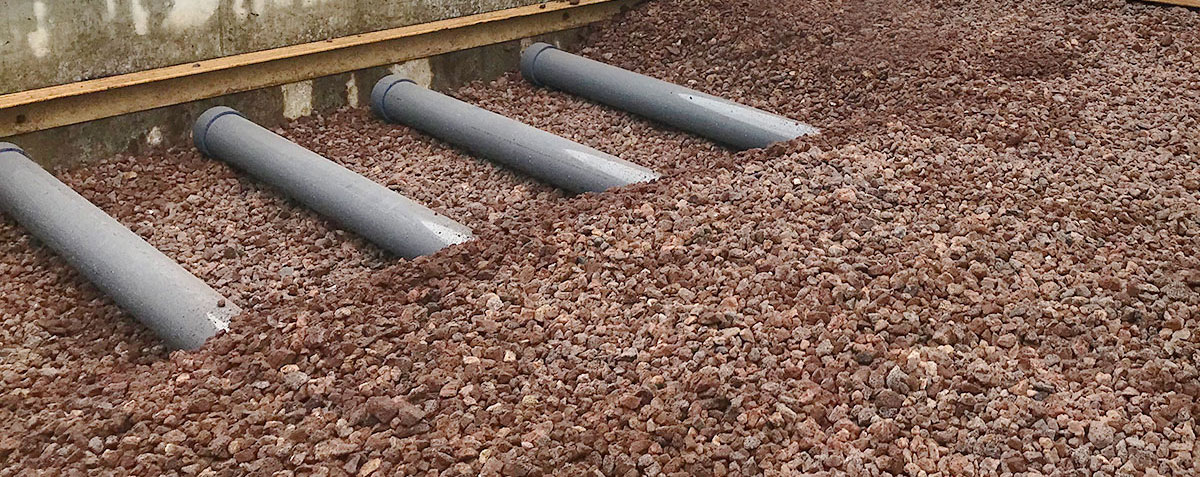
Humidified air is distributed through a network of perforated pipes into a plenum.
Biofiltration is a biological air treatment process that harnesses microbial activity, primarily bacteria and fungi, to degrade volatile organic compounds (VOCs) and odorous compounds.
Traditional biofilter designs employed a humidified air stream distributed through a network of perforated pipes into a plenum composed of smooth stones, which facilitated even airflow distribution through an organic matrix consisting of compost, yard waste, wood chips, and bark.
While this system has been effective for the removal of a variety of odorous compounds and VOCs, its efficacy is compromised in high hydrogen sulfide (H2S) load conditions, necessitating advancements in biofilter media and air distribution systems.
Limitations of Conventional Biofilters in High H2S Load Conditions
Conventional biofilters exhibit substantial performance limitations when exposed to hydrogen sulfide concentrations exceeding 5 ppm.
Elevated H2S levels promote the proliferation of Acidithiobacillus species, which metabolize sulfur compounds and generate sulfuric acid. The accumulation of sulfuric acid within the biofilter matrix leads to a reduction in pH, which adversely affects microbial communities responsible for degrading complex odorants.
This acidic environment results in media compaction, channeling, and premature loss of treatment efficiency. Furthermore, the formation of sulfur deposits from partial H2S oxidation exacerbates performance degradation by coating the media and increasing pressure drop across the system.
Although alkaline materials such as ground oyster shells or limestone may be introduced to buffer pH levels, their effectiveness is transient, as they are rapidly consumed in sulfuric acid production. The formation of mineral nodules further contributes to clogging and necessitates frequent media replacement.
Innovative Dual-Media Biofiltration System
To address these challenges, GES Biotek has developed an advanced dual-media biofiltration system designed to enhance microbial ecosystem stability and prolong biofilter media lifespan. This system comprises two key modifications:
Crater-Max® Inorganic Media
for Air Distribution and Acid-Tolerant Microorganisms
Traditional smooth stone plenums have been replaced with Crater-Max® media, a porous inorganic substrate engineered to provide an extensive surface area for microbial colonization. This material functions both as an airflow distribution medium and as a dedicated habitat for Acidithiobacillus species, which preferentially populate the Crater-Max® layer nearest to the H2S source.
By localizing acid-producing microorganisms to the inorganic media layer, the overall biofilter pH balance is preserved, preventing adverse effects on microbial communities responsible for VOC and odor degradation.
Fiber-Max™ Organic Media
for Enhanced Odor and VOC Removal
The conventional organic biofilter media, comprising compost, yard waste, and wood chips, has been replaced with GES Fiber-Max™, a fibrous organic substrate derived exclusively from trees and large branches free of antimicrobial inhibitors. The material is processed into an average particle size of approximately 4 inches, creating an internal air-filled pore space ranging between 35–55%, which facilitates optimal microbial colonization.
Empirical studies and field installations have demonstrated that Fiber-Max™ mitigates compaction, reduces pressure drop, minimizes odor emissions, and prevents channeling, thereby enhancing treatment efficiency and extending media longevity.
Nutrient Supplementation for Microbial Ecosystem Stability
Maintaining the functional separation of the dual-media ecosystem requires a consistent nutrient supply to sustain Acidithiobacillus populations within the Crater-Max® layer. The optimal approach involves utilizing secondary effluent as the water source for the humidification system, which naturally provides essential nutrients.
In cases where secondary effluent is unavailable, GES Biotek recommends the application of GES 1578, a proprietary nutrient formulation specifically designed to support Acidithiobacillus thiooxidans and Acidithiobacillus ferrooxidans, both of which are critical to sulfur metabolism in biological scrubbers.
Key Features of GES 1578 Nutrient Supplement
- Highly concentrated liquid formulation with a dilution ratio of 3,500:1 (one part nutrient per 3,500 parts water).
- Available in 5-gallon buckets or 260-gallon totes for flexible application.
- Over 20 years of proven efficacy in sustaining microbial activity and optimizing biofilter performance.
Conclusion
The implementation of GES Biotek’s dual-media biofiltration system, incorporating Crater-Max® and Fiber-Max™, represents a significant advancement in air treatment technology. This design effectively mitigates the challenges associated with high H2S loading, preserves microbial ecosystem balance, and extends the operational lifespan of biofilter media. The integration of a tailored nutrient supplementation strategy further enhances system stability, ensuring efficiency in odor and VOC removal in wastewater treatment and industrial applications.